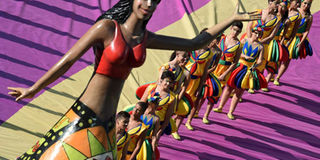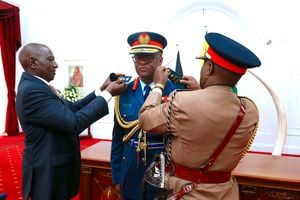Africa to Brazil: One man’s journey of self-rediscovery

Performers take part in the opening ceremony of the 2014 FIFA World Cup at the Corinthians Arena in Sao Paulo, Brazil, on June 12, 2014, prior to the opening Group A football match between Brazil and Croatia. AFP PHOTO / FRANCOIS-XAVIER MARIT
What you need to know:
- Through our journey, we aim to support bright Kenyan kids from a poor background through high school.
- Our goal is to raise $100,000 for this purpose and we pledge to match each private donation with an equal amount donated from us.
I am writing this on June 10, two days to the start of the World Cup, on the request of my editor in Nairobi. I am seated in the back of Pele, our expedition vehicle, with the vast wetlands of Brazil’s Pantanal drifting by as we make our final push to Rio de Janeiro.
Exactly 200 days ago, we embarked on a road journey of more than 40,000 kilometres that would take us from Nairobi through 25 countries around the world to Brazil.
The idea for this journey was born four years ago, during a road trip from Nairobi to the 2010 World Cup in South Africa. Having lived in Brazil more than 10 years ago, I started to dream about driving from Kenya to my former home in Brazil for the World Cup.
I envisioned a land route without any boat crossings and daydreamed about driving across the frozen Bering Strait, the narrowest part of the Pacific Ocean between Siberia and Alaska.
But I quickly realised that this would remain a daydream as there are several thousands of inhospitable kilometres of the coldest land on earth, and without roads, on either side of the Bering Strait.
SHIPPING CONNECTIONS
However, the dream was stuck in my head and, night after night, I was mulling over world maps and researching possible routes that would take me to places I always wanted to explore and would probably never visit if not on this journey.
“Siberia” sounded adventurous, if somewhat threatening, and the goal of crossing Siberia in winter became the cornerstone of my route planning. But how to get from Africa to Siberia, and how to continue to the American continent?
It took several months of research to get clarity on these questions, taking into account security considerations, shipping connections and visa regulations. Initially, I intended to drive from Nairobi to Cairo, cross the Mediterranean to Turkey and then head east.
Suddenly, however, Egypt exploded in political riots and the shipping connections between Egypt and Turkey were discontinued, forcing me to look into various alternatives: the land connection between Israel and Turkey is blocked due to the Civil War in Syria, Iraq is a no-go zone, Saudi Arabia is extremely restrictive with issuing tourist visas and doesn’t allow any right-hand-drive vehicles.
BIGGEST CHALLENGE
Therefore, the only feasible route seemed to drive via Ethiopia to Djibouti, ship our vehicle to Oman, drive to Dubai and take a ferry across the Persian Gulf to Iran.
From Iran, we planned to drive through Central Asia to Mongolia and then across Siberia to the Pacific Ocean. The biggest challenge was to get our vehicle from Russia to the US.
To my great surprise, I learned that there are no direct shipping connections between the world’s two superpowers. We had to plan for a stopover in Japan, and a container ship from there to Los Angeles would take an entire month!
Once in the Americas, the route looked clear and easy: through Mexico and Central America and along the Andes to Brazil. However, a final sea crossing would be necessary to get from Central to South America.
Even though there is a land bridge between Panama and Colombia, this is impenetrable jungle and drug trafficking country, and there is no road that connects these two countries.
Thus, our route entailed a total of five ocean crossings and we built in 40 buffer days to ensure we would arrive in time for the start of the World Cup, even if the shipping connections didn’t work out as planned.
LOGISTICS
This turned out to be vital as shipping the vehicle took much longer than planned and in spite of the buffer days, we almost missed the crucial container ship from Japan to the US.
Once the route was clear, I turned my attention to the countless other logistics for the journey. This included obtaining visa. As around 20 friends and colleagues from all around the world were planning to join me on different parts of the trip, it took quite some time to figure out the visa requirements.
For myself, I had to arrange visas for eight countries prior to the start of the journey and had to travel to Europe to apply for the visa of several countries that don’t have an embassy in Nairobi.
A reliable expedition vehicle was crucial for the success of our journey. Given the expected rough roads and freezing winter temperatures in Siberia, I wanted a strong car with a manual gearbox and as few electronics as possible.
It took us several months to find Pele, a 1997 Turbodiesel Toyota Land Cruiser, and several more weeks to get him ready for the journey. Pele turned out to be the perfect choice — 42,000km into the journey, he has run smoothly and apart from routine maintenance and replacements, has had no issues... and not even a single flat tyre!
'VEHICLE PASSPORT'
In spite of almost three years of planning, the last couple of days before our departure were extremely hectic. At 4pm on the day before leaving Nairobi, we finally received the Carnet de Passage, a kind of vehicle passport and a crucial document for Pele to be allowed into Iran and Central Asia.
Finally, the day of departure was there! On a sunny morning in late November last year, we had a cheerful send off from Nairobi and set out for our journey around the world.
Driving through remote and dramatic northern Kenya was a great start for our trip, and many other spectacular drives would follow — through the grandiose Omo Valley in Ethiopia, moon-like landscapes in Djibouti and Oman, majestic deserts of Iran, infinite plains, mountains and valleys of Mongolia and Siberia, over frozen Lake Baikal, along beautiful Caribbean beaches, through lush Central American jungles and finally across the at times vertigo-inducing Andes in South America.
The first two months of our journey passed without any hiccups, but we knew that eventually we would be caught by winter and extremely cold temperatures.
As if it was yesterday, I remember the day this eventually happened: it was an early morning, still dark and snowing heavily — we were leaving Almaty in Kazakhstan, Central Asia, heading north towards Siberia.
RUDE SHOCK
This will remain in my memory the moment the real adventure of our journey around the world began, and I vividly recall the sense of joy, anxiety, excitement, anticipation and freedom as we were driving through the endless Kazakh steppe, surrounded by featureless white nothingness.
Two days later, after crossing the border to Russia, we woke up to a rude shock — Siberian temperatures had dropped to -33°C overnight, so cold that it was difficult to breathe. Pele didn’t even make the faintest yelp when we turned the key in the ignition.
Initially, we thought that the cold had drained the batteries, but we soon realised that the diesel fuel had frozen. The only thing we could do was to have Pele trucked to a heated local garage for de-freezing.
Over the next couple of weeks, we learned how to protect Pele from the arctic night temperatures by adding a can of anti-freeze to the fuel, covering the bonnet with thick blankets or even mattresses, closing the exhaust with a piece of cloth, and getting up every two hours throughout the night to run the engine for 20 to 30 minutes.
Other challenges during the journey were the nail-biting bureaucracy during border crossings, especially in Central Asia, where mysterious forms in Cyrillic script had to be filled and crossing borders took three to four hours.
LANGUAGE BARRIER
The language barrier added to the adventure of traversing Iran, Central Asia and Russia in winter. Simple things we normally take for granted turned into tests of persistence and ingenuity. Decoding Persian and Cyrillic street signs and restaurant menus were at times hilarious experiences!
In Japan, there was a moment when I thought that our journey might be over. Kenyan driving licences are not valid in Japan because Kenya hasn’t signed some international convention on driving licences.
I wasn’t aware of this until we arrived, and as we had to catch the container ship to the US three days later, we had no option but to drive across Japan and take the risk of being caught.
And caught I was! As a result, I spent an entire Sunday at the Tokyo airport police station, being interrogated about illegally driving in Japan by an army of police officers who seemed to have nothing else to do and who kept asking me the same questions over and over again.
They were polite but very serious-looking, and just as I thought that I would spend the next decade in a Japanese high-security prison, their shift ended, and suddenly they were in a hurry to get rid of me.
UNEXPECTED EXPERIENCES
The unexpected experiences and encounters with local people, to me, are the biggest joy in travelling, and these are the moments I cherished most.
We stumbled upon a traditional bull-jumping ceremony in Ethiopia, stayed with an Iranian family in a small fishing village in the Persian Gulf, went camel riding with local herders in Mongolia, had the most exhilarating day exploring and snowboarding over frozen Lake Baikal, spent a freezing night in a cosy Siberian chalet complete with traditional Russian sauna, smoked shisha on the sunny ski slopes in Iran, and met Laura, an elderly and blind lady who every day plays the accordion in a historic square in Quito to supplement her meagre pension, and who, in spite of her difficult life circumstances, radiates a joy of life that touched me deeply.
There are many moments during this journey that I will treasure and forever carry in my heart, and I am not the same person who left Nairobi seven months ago. Travelling opens the heart and somehow encourages the people we meet to open up as well.
One observation that struck me is that, however different people may be in their customs, beliefs, clothing, architecture or food, their kindness is similar everywhere. Coming to the close of this journey, I feel, in spite of its many glaring evils, inspired by humanity.
PURSUING A DREAM
Wherever we stopped on our journey, we were soon surrounded by people of all ages who always asked us the same questions. Where do you come from and where are you going? Why are you doing this journey?
So, why this journey? The answer is simple: to follow our curiosity and discover the world; to explore breathtaking landscapes crossing swamps, savannahs, deserts, mountains and oceans; to expand our horizons and gain new perspectives meeting people from diverse backgrounds and cultures; and to learn about ourselves.
Why this journey? To live a once-in-a-lifetime adventure, and to pursue a dream.
I would be happy if this story is an inspiration for other people to also pursue their dreams, however crazy they may seem. Furthermore, through our journey, we aim to support bright Kenyan kids from a poor background through high school.
Our goal is to raise $100,000 for this purpose and we pledge to match each private donation with an equal amount donated from us (for more info on this, see www.africatobrazil.com).



